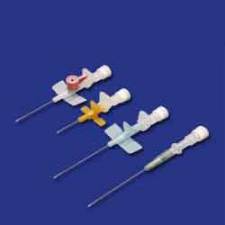by Mr Mike Yeats Derriford Hospital, Plymouth, UK.
Reproduced with permission from Update in Anaesthesia
Introduction
This is the first of two articles describing the maintenance of sphygmomanometers. The first deals with mercury type machines, and the second aneroid gauges.
A mercury sphygmomanometer is operated by inflating a rubber cuff placed around a patient's arm until blood flow stops. The cuff pressure is measured via the mercury column.

The figure shows the parts of a mercury sphygmomanometer. The inflating bulb is used to inflate the cuff. It contains two one-way valves. Valve A allows air to enter the back of the bulb. When the bulb is squeezed this valve closes and the air is propelled through valve B to the cuff. Valve B stops the air going back into the bulb.
After the cuff has been inflated and the blood pressure taken, the cuff may be deflated by opening valve C. The reservoir contains the supply of mercury which rises up the measurement tube. Normally the apparatus is contained within a box. When opened the graduated tube becomes vertical, and the mercury reservoir is at the bottom. As the pressure within the cuff increases the mercury is displaced from the reservoir into the graduated tube. The two leather discs (D and E) allow air to pass in and out of the column, but prevent mercury escaping from the sphygmomanometer.
The following points are important for accurate blood pressures: The inflatable part of the cuff must be the correct size for the arm. It should cover two thirds of the length of the upper arm. A blood pressure cuff which is too small will cause an abnormally high blood pressure reading and a low reading may result from too large a cuff. The cuff should be firmly applied with the centre of the inflatable part over the brachial artery.
The cuff must be free of leaks.
The mercury should be clean and at the zero mark before use.
During cuff inflation the mercury should rise smoothly, and stop immediately inflation stops.
Problems with the mercury sphygmomanometer
Remember mercury vapour is poisonous. Any maintenance should be performed in an area of good ventilation. Store mercury in a plastic bottle with a little water placed on top of the mercury. Be careful not to inhale black mercuric oxide powder during cleaning procedures.
Black discoloration of the mercury. The mercury should be a clean silver colour. With time, a black powder (mercuric oxide), forms on the surface.
A little black powder in the column does not matter. If there is a large amount, the mercury should be removed from the sphygmomanometer and the column and reservoir cleaned. Do this by laying the machine on its side with the reservoir downwards. Remove the column, ensure that you do not lose the leather disc at the top. Undo the reservoir top and pour the mercury out into a plastic bottle.
Blow the reservoir and the leather disc in the reservoir top clean with compressed air and wipe with a cloth. (If you don't have compressed air, take an old blood pressure inflation bulb, find a large bore needle, file off the tip and fit it to the inflation bulb. By squeezing the inflation bulb you will have a source of compressed air). Clean the inside of the column and replace it. Remember to replace the leather disc at the top and the washer at the bottom.
Replace the mercury in the reservoir to the zero mark. Use a syringe and needle to draw up the mercury from the plastic bottle. Keep the needle under the surface of the mercury to avoid returning any black powder. Replace the reservoir top with its sealing ring, connect the cuff and check the system is airtight by inflating the cuff until the mercury is at the top of the column. Check that it does not spill out-if this happens, the top leather disc is faulty or missing. (This disc should allow the air to pass in and out as the mercury rises and falls, but not allow mercury to escape.)
Mercury continues to rise slowly after stopping inflation. This is caused by the air at the top of the column failing to escape through the top leather disc quickly enough as the mercury rises up the column. When the sphygmomanometer is used, this fault may result in abnormally high readings as the mercury falls more slowly than the cuff pressure, due to the faulty leather disc restricting the air entering the top of the column.
The cause of these faults is in the top leather disc. It is either too thick or dirty. It should be removed as described before and cleaned. Replace it and test the sphygmomanometer. If the fault persists, remove the disc. Holding it between your finger and thumb on a flat surface, gently scrape it with a scalpel blade. Turn it continually to ensure it keeps its round shape and take care not to put a hole in it. Refit.
The mercury does not rise but the cuff inflates. This indicates blockage at D in the figure or a kinked or obstructed tube.
The cuff will not inflate or mercury rise. This indicates that there is a leak. Check valves A, B and C, the rubber bladder, tubing and connections. Rubber bladders may be repaired with an ordinary bicycle tyre puncture kit. Valve B can usually be removed and cleaned. Valve A may be a small ball bearing which can be removed from its cage and, with care, cleaned and replaced. Valve C cannot normally be removed.
After full assessment reassemble the sphygmomanometer and test.
©World Federation of Societies of Anaesthesiologists








